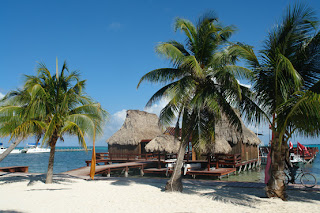Pirates, Parrots and Monkeys:
By Chris Millikan
For seven glorious days, Carnival’s Valor drops my hubby and me at a series of hot-hot-hot Caribbean ports for sunny adventures. Isla Roatan, a tropical island 30 miles off the northern Honduran mainland is no different. First glimpsed from our balcony, this emerald isle sparkles in the morning sun, and buzzes with construction of its new cruise ship terminal.
Flamboyantly costumed and masked Garifuna performers welcome us ashore, dancing wildly and chanting to frenetic drum music from their African heritage. Like us, everyone stops for photos!
With a couple of adventurous friends in tow, we dodge waiting tour buses and craft market frenzy, eager to explore beyond this bustling pier. Quickly striking a deal with David, a 16-year-old guide, we taxi northward from Coxen Hole, the island’s most populated town.
Driver Luis speaks only Spanish; David speaks excellent English, guiding visitors like us by day and attending school at night. When asked about the remarkable traditional dancers at the pier, David explains, “Long ago local natives and shipwrecked Africans intermarried, creating a new culture. Nowadays, about 200,000 Garifuna live in the Caribbean, mainly in Honduras, Belize and Guatemala.”
(to be continued)
By Chris Millikan
For seven glorious days, Carnival’s Valor drops my hubby and me at a series of hot-hot-hot Caribbean ports for sunny adventures. Isla Roatan, a tropical island 30 miles off the northern Honduran mainland is no different. First glimpsed from our balcony, this emerald isle sparkles in the morning sun, and buzzes with construction of its new cruise ship terminal.
Flamboyantly costumed and masked Garifuna performers welcome us ashore, dancing wildly and chanting to frenetic drum music from their African heritage. Like us, everyone stops for photos!
With a couple of adventurous friends in tow, we dodge waiting tour buses and craft market frenzy, eager to explore beyond this bustling pier. Quickly striking a deal with David, a 16-year-old guide, we taxi northward from Coxen Hole, the island’s most populated town.
Driver Luis speaks only Spanish; David speaks excellent English, guiding visitors like us by day and attending school at night. When asked about the remarkable traditional dancers at the pier, David explains, “Long ago local natives and shipwrecked Africans intermarried, creating a new culture. Nowadays, about 200,000 Garifuna live in the Caribbean, mainly in Honduras, Belize and Guatemala.”
(to be continued)









